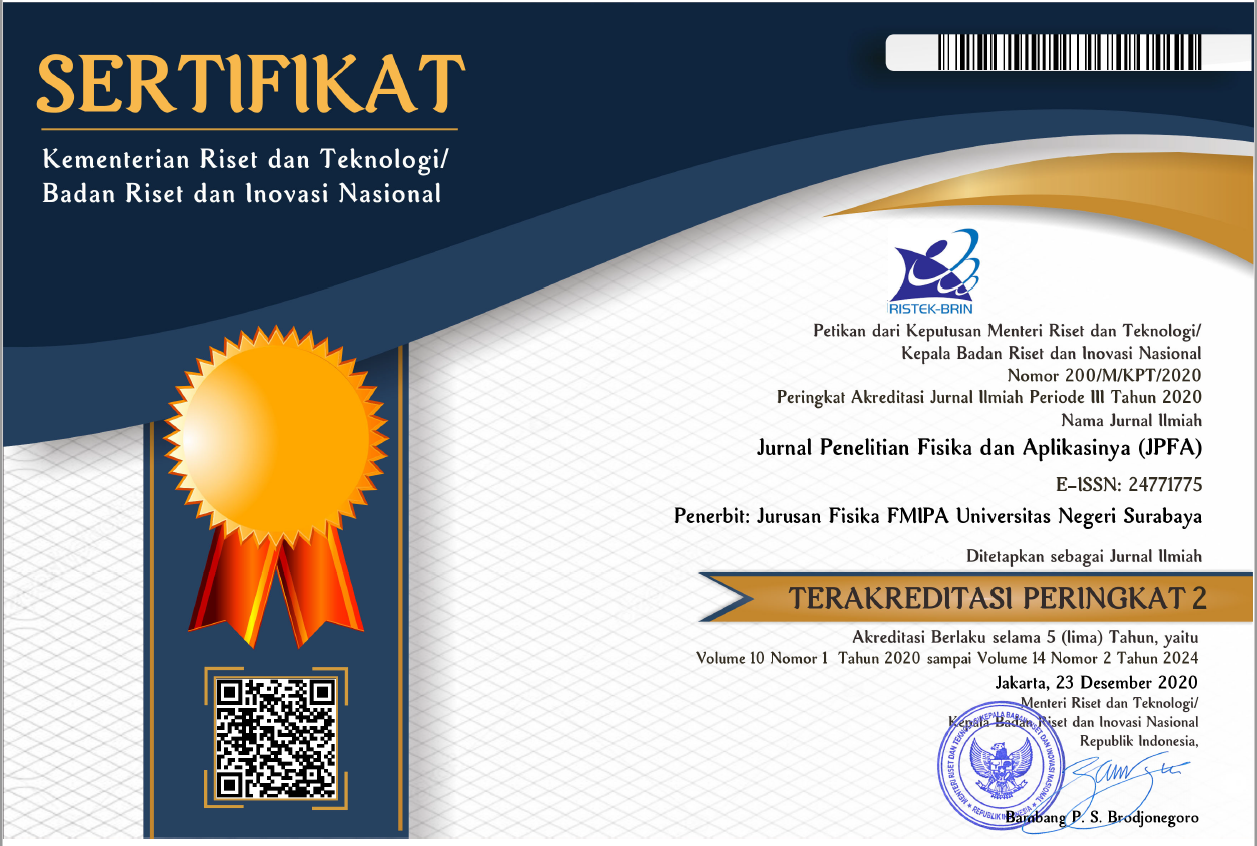Optical Properties Comparison of Carbon Nanodots Synthesized from Kangkung (Ipomoea aquatica) with Deep Frying and Roasting Techniques
DOI:
https://doi.org/10.26740/jpfa.v9n2.p123-131Keywords:
C-dots, kangkung, frying technique, roasting techniqueAbstract
Carbon nanodots (Cdots) have many unique properties such as luminescence that can be utilized in various fields. The purposes of this study are to synthesize Cdots from kangkung (Ipomoea aquatica) through frying and roasting techniques and compare the optical properties of the Cdots using UV-Vis, PL, and FTIR. Three stages of synthesizing process of Cdots, i.e.: preparing the kangkung powder (root, stem, leaf) and synthesizing the Cdots through frying and roasting techniques. Each part (root, stem, and leaf) was heated in an oven at 250 oC for 2 hours and mashed into powder. The frying method was done by frying 15 g of the powder in 120 ml oil for 5 minutes at 88 oC, filtered, and dissolved in n-hexane. In addition, the roasting method was done by frying the powder without oil as much as 15 g for 5 minutes, dissolved in 120 ml of distilled water, and then filtered. The UV-Vis characterization showed one absorbance peak for Cdots via frying and roasting techniques at 293 nm to 296 nm and 262 nm to 282 nm, respectively. The Cdots through frying and roasting techniques produce red and green luminescence, respectively. The FTIR characterization showed the presence of C=C and C=O functional groups, which are the core and surface state of the Cdots by frying technique, while the samples via roasting technique showed only the core. It can be concluded that the Cdots samples obtained from frying and roasting methods have different optical properties. The frying method produces Cdots with longer wavelength at the absorbance peak in the UV-Vis test compared to the roasting method. Moreover, the frying and roasting methods produce different color luminescence.
References
Djojosuwit S. Azolla: Pertanian Organic san Multiguna. Yogyakarta: Kanisius; 2000.
Liu XJ, Guo ML, Huang J, and Yin XY. Improved Fluorescence of Carbon Dots Prepared from Bagasse under Alkaline Hydrothermal Conditions. BioResources. 2013; 8(2): 2537-2546. Available from:
https://ojs.cnr.ncsu.edu/index.php/BioRes/article/view/BioRes_08_2_2537_Liu_Fluorescence_Carbon_Dots.
Bhattacharya S, Sarkar R, Chakraborty B, Porgador A, and Jelinek R. Nitric Oxide Sensing through Azo-Dye Formation on Carbon Dots. ACS Sensors. 2017; 2(8): 1215-1224. DOI:
https://doi.org/10.1021/acssensors.7b00356.
Georgakilas V, Perman JA, Tuce J, and Zboril R. Broad Family of Carbon Nanoalltropes: Classification, Chemistry, and Aplications of Fullerenes, Carbon Dots Nanotubes, Graphene, Nanodiamonds, and Combined Superstructures. Chemical Reviews. 2005; 115(11): 4744-4822. DOI:
https://doi.org/10.1021/cr500304f.
Bao L, Liu C, Zhang ZL, and Pang DW. Photoluminescence-Tunable Carbon Nanodots: Surface-State Energy-Gap Tuning. Advanced Materials. 2015; 27(10): 1663-1667. DOI:
http://doi.org/10.1002/adma.201405070.
Niu J, Gao H, Wang L, Xin S, Zhang GY, Wang Q, Guo L, Liu W, Gao X, and Wang Y. Facile Synthesis and Optical Properties of Nitrogen-Doped Carbon Dots. New Journal of Chemistry. 2013; 38(4): 1522-1527. DOI: http://dx.doi.org/10.1039/C3NJ01068F.
Bao YW, Hua XW, Li YH, Jia HR, and Wu FG. Hyperthemia Promoted Cytosolic and Nuclear Delivery of Coppercarbon Quantum Dot-Crosslinked Nanosheets: Multimodal Imaging-Guided Photothermal Cancer Therapy. ACS Applied Materials and Interfaces. 2018; 10(2): 1544-1555. DOI:
https://doi.org/10.1021/acsami.7b15332.
Wang L, Haoran Z, Zhou X, Liu Y, and Lei B. A Dual-Emitting Core-Shell Carbon Dot-Sillica-Phosphor Composite for LED Plant Grow Light. RSC Advances. 2017; 7(27): 16662-16667. DOI:
https://doi.org/10.1039/C7RA00227K.
Suzuki K, Malfatti L, Takashi M, Carboni D, Messina F, Tokudome Y, Takemoto M, and Innocenzi P. Design of Carbon Dots Photoluminescence Through Organo-Functional Silane Grafting for Solid-State Emitting Devices. Scientific Reports. 2017; 7: 5469. DOI:
https://doi.org/10.1038/s41598-017-05540-5.
Hasan MH, Mahlia TMI, and Nur H. A Review on Energy Scenario and Sustainable Energy in Indonesia. Renewable and Sustainable Energy Reviews. 2012; 16(4): 2316-2328. DOI:
https://doi.org/10.1016/j.rser.2011.12.007.
Liu H, Ye T, and Mao C. Fluorescent Carbon Nanoparticles from Candle Soot. Angewandte Chemie Internasiona Edition. 2007; 46(34): 6473-6475. DOI:
https://doi.org/10.1002/anie.200701271.
Dewi ARC, Aji MP, and Sulhadi. Absorbance Spectrum Carbon Nanodots (C-Dots) Daun Tembakau. Proceedings of Seminar Nasional Fisika SNF 2016. Fakultas Matematika dan Ilmu Pengetahuan Alam, Universitas Negeri Jakarta. 2016; 5: 129-134. Available from: http://journal.unj.ac.id/unj/index.php/prosidingsnf/article/view/4182.
Fatimah S, Isnaeni I, and Tahir D. Assisted Surface-state Recombination of Orange-peel Carbon Nanodots in Various Matrices. Makara Journal of Science. 2018; 22(1): 29-34. DOI:
https://doi.org/10.7454/mss.v22i1.8301.
De B and Karak N. A Green and Facile Approach for the Synthesis of Water Soluble Fluorescent Carbon Dots from Banana Juice. RSC Advances. 2013; 3(22): 8286-8290. DOI: http://dx.doi.org/10.1039/C3RA00088E.
Haryoto. Bertanam Kangkung Raksasa di Pekarangan. Yogyakarta: Kanisius; 2009.
Arsalani N, Nezhad-Mokhtari P, and Jabbari E. Microwave-Assisted and One-Step Synthesis of PEG Passivated Fluorescent Carbon Dots from Gelatin as an Efficient Nanocarrier for Methotrexate Delivery. Journal Artificial Cells, Nanomedicine, and Biotechnology. 2019; 47(1): 540-547. DOI: https://doi.org/10.1080/21691401.2018.1562460.
Soni S and Loi MA. Luminescent Carbon Dots: Characteristics and Applications; 2016. Available from:
https://www.rug.nl/research/zernike/education/topmasternanoscience/ns190_soni.pdf.
Fadli AL. Sintesis dan Karakterisasi Nanomaterial Carbon-Dot, Carbon-Dot/Sulfur, dan Carbon-Dot/Silver Nanoparticle Berbahan Dasar Buah Namnam (Cynometra cauliflora L) dengan Metode Penggorengan Berbasis Minyak. Undergraduate Thesis. Unpublished. Yogyakarta: Universitas Negeri Yogyakarta; 2018.
Sun YP, Zhou B, Lin Y, Wang W, Fernando, KAS, Pathak P, Meziani MJ, Harruff BA, Wang X, Wang H, Luo, PG, Yang H, Kose ME, Chen B, Veca LM, and Xie SY. Quantum-Sized Carbon Dots for Bright and Colorful Photoluminescence. Journal of the American Chemical Society. 2006; 128(24): 7756-7757. DOI: https://doi.org/10.1021/ja062677d.
Mewada A, Vishwakarma R, Patil B, Phadke C, Kalita G, Sharon M, and Sharon M. Non-Blinking Dendritic Crystal from C-Dots Solution. Carbon Letters. 2015; 16(3): 211-214. DOI:
http://dx.doi.org/10.5714/CL.2015.16.3.211.
Li L, Zhang R, Lu C, Sun J, Wang L, Qu B, Li T, Liu Y, and Li S. In Situ Synthesis of NIR-Light Emitting Carbon Dots Derived from Spinach for Bio-Imaging Applications. Journal of Materials Chemistry B. 2017; 5(35): 7328-7334. DOI: http://doi.org/10.1039/C7TB00634A.
Wu H, Zhou F, Zhu Z, and Chen Y. On the Distance Spectrum Assignment in Elastic Optical Networks. Journal IEEE/ACM Transactions on Networking (TON). 2017; 25(4): 2391-2404. DOI:
http://dx.doi.org/10.1109/TNET.2017.2685688.
Wang L, Zhu SJ, Wang HY, Qu SN, Zhang YL, Zhang JH, and Sun HB. Common Origin of Green Luminescence in Carbon Nanodots and Graphene Quantum Dots. ACS Nano. 2014; 8(3): 2541-2547. DOI:
https://doi.org/10.1021/nn500368m.
Himaja AL, Karthik PS, and Singh SP. Carbon Dots: The Newest Member of the Carbon Nanomaterials Family. The Chemical Record. 2015; 15(3): 595-615. DOI: http://doi.org/10.1002/tcr.201402090.
Zhang J, Wang H, Xiao Y, Tang J, Liang C, Li F, Dong H, and Xu W. A Simple Approach for Synthesizing of Fluorescent Carbon Quantum Dots from Tofu Wastewater. Nanoscale Research Letters. 2017; 12: 611. DOI: https://doi.org/10.1186/s11671-017-2369-1.
Campos BB, Contreras-Caceres R, Bandosz TJ, Jimenez-Jimenez J, Rodriguez-Castellon E, Esteves da Silva JCG, and Algarra M. Carbon Dots as Fluorescent Sensor for Detection of Explosive Nitrocompounds. Carbon. 2016; 106: 171-178. DOI: https://doi.org/10.1016/j.carbon.2016.05.030.
V R, Gujar V, Pathan H, Islam S, Tawre M, Pardesi K, Santra MK, and Ottoor D. Bioimaging Applications of Carbon dots (C. dots) and its Cystamine Functionalization for the Sensitive Detection of Cr(VI) in Aqueous Samples. Journal of Fluorescence. 2019; 29: 1381-1392. DOI:
https://doi.org/10.1007/s10895-019-02448-3.
Shukla D, Pandey FP, Kumari P, Basu N, Tiwari MK, Lahiri J, and Parmar AS. LabelFree Fluorometric Detection of Adulterant Malachite Green Using Carbon Dots Derived from the Medicinal Plant Source Ocimum tenuiflorum. Chemistry Select. 2019; 4(17): 48394847. DOI: http://dx.doi.org/10.1002/slct.201900530.
Downloads
Published
How to Cite
Issue
Section
License
Author(s) who wish to publish with this journal should agree to the following terms:
- Author(s) retain copyright and grant the journal right of first publication with the work simultaneously licensed under a Creative Commons Attribution-Non Commercial 4.0 License (CC BY-NC) that allows others to share the work with an acknowledgement of the work's authorship and initial publication in this journal for noncommercial purposes.
- Author(s) are able to enter into separate, additional contractual arrangements for the non-exclusive distribution of the journal's published version of the work (e.g., post it to an institutional repository or publish it in a book), with an acknowledgement of its initial publication in this journal.
The publisher publish and distribute the Article with the copyright notice to the JPFA with the article license CC-BY-NC 4.0.
 Abstract views: 1063
,
Abstract views: 1063
, PDF Downloads: 755
PDF Downloads: 755









